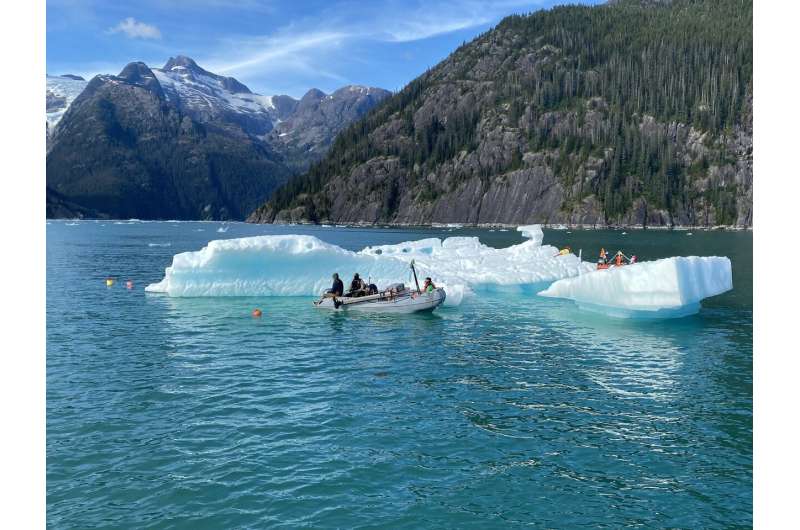This article has been reviewed according to Science X's editorial process and policies. Editors have highlighted the following attributes while ensuring the content's credibility:
fact-checked
peer-reviewed publication
trusted source
proofread
Bursting air bubbles may play a key role in how glacier ice melts, research suggests

Oregon State University research has uncovered a possible clue as to why glaciers that terminate at the sea are retreating at unprecedented rates: the bursting of tiny, pressurized bubbles in underwater ice.
Published in Nature Geoscience, the study shows that glacier ice, characterized by pockets of pressurized air, melts much more quickly than the bubble-free sea ice or manufactured ice typically used to research melt rates at the ocean-ice interface of tidewater glaciers.
Tidewater glaciers are rapidly retreating, the authors say, resulting in ice mass loss in Greenland, the Antarctic Peninsula and other glacierized regions around the globe.
"We have known for a while that glacier ice is full of bubbles," said Meagan Wengrove, assistant professor of coastal engineering in the OSU College of Engineering and the leader of the study. "It was only when we started talking about the physics of the process that we realized those bubbles may be doing a lot more than just making noise underwater as the ice melts."
Glacier ice results from the compaction of snow. Air pockets between snowflakes are trapped in pores between ice crystals as the ice makes its way from the upper layer of a glacier to deep inside it. There are about 200 bubbles per cubic centimeter, meaning glacier ice is about 10% air.
"These are the same bubbles that preserve ancient air studied in ice cores," said co-author Erin Pettit, glaciologist and professor in the OSU College of Earth, Ocean, and Atmospheric Sciences. "The tiny bubbles can have very high pressures—sometimes up to 20 atmospheres, or 20 times normal atmospheric pressure at sea level."
When the bubbly ice reaches the interface with the ocean, the bubbles burst and create audible pops, she added.
"The existence of pressurized bubbles in glacier ice has been known for a long time but no studies had looked at their effect on melting where a glacier meets the ocean, even though bubbles are known to affect fluid mixing in multiple processes ranging from industrial to medical," Wengrove said.
Lab-scale experiments performed in this study suggest bubbles may explain part of the difference between observed and predicted melt rates of tidewater glaciers, she said.
"The explosive bursts of those bubbles, and their buoyancy, energize the ocean boundary layer during melting," Wengrove said.
That carries huge implications for the way ice melt is folded into climate models, especially those that deal with the upper 40 to 60 meters of the ocean—the researchers learned glacier ice melts more than twice as fast as ice with no bubbles.
"While we can measure the amount of overall ice loss from Greenland over the last decade and we can see the retreat of each glacier in satellite images, we rely on models to predict ice melt rates," Pettit said. "The models currently used to predict ice melt at the ice-ocean interface of tidewater glaciers do not account for bubbles in glacier ice."
Right now, data from NASA attributes about 60% of sea level rise to meltwater from glaciers and ice sheets, the authors note. More accurate characterization of how ice melts will lead to better predictions of how quickly glaciers retreat, which is important because "it's a lot more difficult for a community to plan for a 10-foot increase in water level than it is for a one-foot increase," Wengrove said.
"Those little bubbles may play an outsized role in understanding critical future climate scenarios," she added.
More information: Melting of glacier ice enhanced by bursting air bubbles, Nature Geoscience (2023). DOI: 10.1038/s41561-023-01262-8 , www.nature.com/articles/s41561-023-01262-8
Journal information: Nature Geoscience
Provided by Oregon State University




















